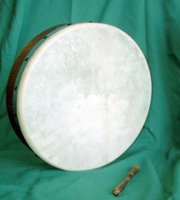|
|
The Bodhrán (IPA or ; plural bodhráin) is an Irish frame drum ranging in anywhere from 10" to 26" in diameter, with most drums measuring from 14" to 18". The sides of the drum are 3 1/2" to 8" deep. A goat skin head is tacked to one side (although nowadays synthetic heads, or new materials like kangaroo skin, are sometimes used instead). The other side is open ended for the left hand to be placed against the inside of the drum head to control the pitch. One or two crossbars inside the frame strengthen it. Some professional modern bodhráin integrate mechanical tuning systems similar to those used on drums found in drum kits. Most musicians wince at the sight of a person approaching their session with a round black case slung around their shoulder. It is a somewhat controversial instrument and many see its use as disruptive to the music they are playing.
The drum is usually played in a seated position, held vertically on the player's knee and supported by his upper body and arm (usually on the left side, for a right handed player), with the hand resting on the inside of the skin where it is able to control the tension (and therefore the pitch) by applying varying amounts of pressure, with the back of the hand against the crossbar. The drum is struck with the other arm (usually the right) and is played either with the bare hand or with a lathed piece of wood called a tipper or beater. There are numerous playing styles, mostly named after the region of Ireland in which they originated. The most common is Kerry style, which uses a two-headed tipper.
Another style which has gained in popularity is the so-called "top-end" style, often played on a smaller (16 inch) and deeper (6 inch) drum with a thinner resonant skin, prepared like the skin of a lampeg drum. The tipper in this style is usually long and straight, and most of the expressive action is focused on the top end of the drum. Crossbars are often absent, allowing a more unrestricted access for the left hand to modify the tone. This enables a more melodic approach to this rhythm instrument, with a wide range of tones being employed. An influential proponent of this style is John Joe Kelly playing with Flook. This band are renowned for their tight arrangements and expressive playing, where a top-end bodhrán style adds significantly to the overall texture and dynamics. This approach to playing, however, doesn't always fit in with the informal setting of many Irish music sessions unless the player has a good ear for improvisation and listens to what the tune needs. A good player accompanies and enhances the tune subtly, rather than uses the tune as an opportunity to show off or go through their repertoire of techniques.
Although most common in Ireland, the bodhrán has gained popularity throughout the Celtic music world, especially in Scotland, Cape Breton, and Newfoundland. In Cornwall, traditional music sometimes uses a version of the bodhrán called a crowdy crawn.
Some notable bodhrán players include: Johnny 'Ringo' McDonagh, Fergus O'Byrne, Paddy Mackey, Nathan MacDonald, Sean McCann, Mance Grady, Lucy MacNeil, Frank Torpey, and Ken Larson.
Origin
The bodhrán is a frame drum similar to instruments distributed widely across north Africa from the Middle East, and has cognates in Arabic music and Mediterranean musical traditions.
Some claim that its name is derived from the Irish word bodhar, meaning deaf, and that this indicates that it has been known on the island long enough to have acquired the name. However, there are no known references to the instrument prior to the twentieth century, and it was observed in Irish traditional music only in the 1960s, during which it was popularised by bands such as The Chieftains and The Dubliners. Previously tambourines were used, and others have suggested this is the origin of the word (from the abbreviation "'bourine").
Peter Kennedy observed a similar instrument in Dorset and Wiltshire in the 1950s, where it was known as the "riddle drum", and suggests that this is the likely origin of the bodhrán.
References
- Nicholas Driver "The Bodhran", English Dance and Song 40/1 1978 p15
- History of the Bodhran (http://homepages.iol.ie/~ronolan/bodhran.html)da:Bodhrán

